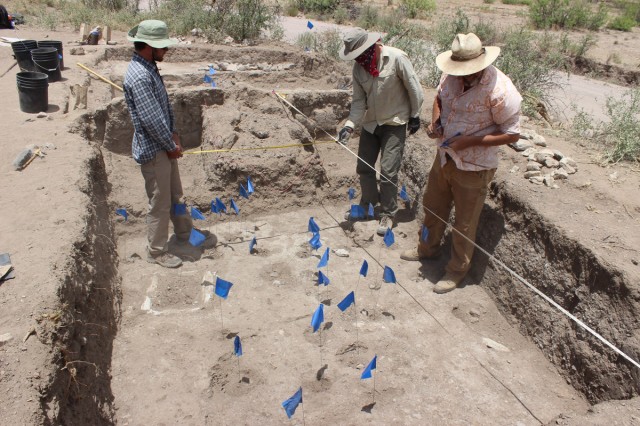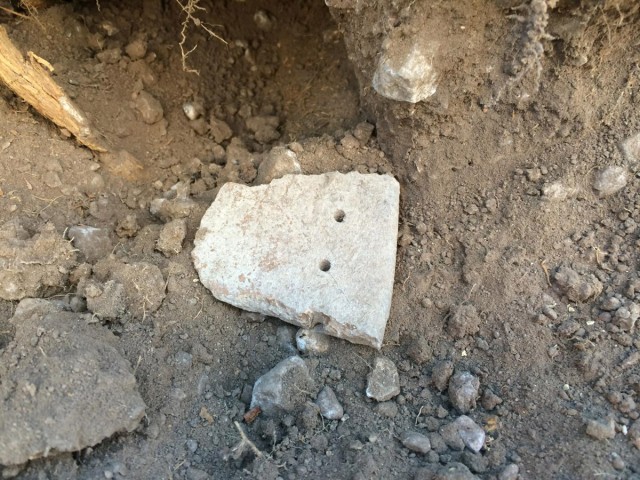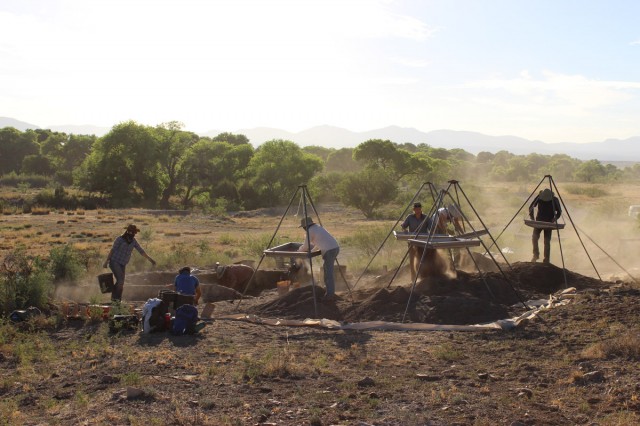- Home
- >
- Preservation Archaeology Blog
- >
- Even the Smallest Piece
Will Russell, Field Supervisor
One of the highlights of teaching is the look of discovery and excitement on a student’s face. Recently, I was wiping sweat from my eyes and filling out paperwork amidst a cloud of dust shaken from the screens when I heard Andrew say, “Hey, Will, take a look at this!” I swatted gnats away and saw Andrew walking toward me with something in his hand. We met at the unit boundary, where he handed me a pottery sherd. It was dirtier than most and I couldn’t see any paint. It had what looked like a line of tool punch marks near the rim. On closer inspection, these began to look more like holes than decorative divots. Could it be?

I looked at the sherd in profile and saw very little curvature. I pulled a thorn from my pant leg and poked at the holes. Dirt fell away and sunlight filtered through. What I was holding in my hand was a piece of “perforated plate” that had been buried for 600 years or more. The students had seen pictures of perforated plates in journal articles and slide shows. They’d seen several examples at Arizona State Museum. Just the night before, we’d again discussed how perforated plates serve as markers of Kayenta emigration. Small pieces of broken pottery can, in fact, give us clues and answers to questions of who, what, when, where, and – if we’re lucky – why.

Movement has been a major force in shaping Native American identity in the Southwest, and perforated plates are not the only kind of pottery that helps us recognize episodes of migration and diaspora. Maverick Mountain Polychrome is likewise associated with Kayenta migrants, and archaeologists have long used carbon-painted white wares to suggest Mesa Verde migration into the upper Rio Grande. Some pottery types were made in certain areas and exchanged far and wide. For example, Kwakina Polychrome was made in the Cibola region. If we find it elsewhere, we can be reasonably sure that some social connection with people in the Cibola area existed. Other pottery, such as Gila Polychrome, was made in many areas throughout the Southwest. Despite this widespread distribution, the designs painted on these pots are remarkably similar. Thus, while we can’t easily know where a given pot was made, we can discuss shared ideas and beliefs that may have contributed to the stylistic homogeneity.
By examining the ways in which ancient potters chose to decorate their vessels, we can gain insight into their lives and the social messages they hoped to convey. This is inherently speculative, but by comparing ancient and historic designs, we can begin to infer some meanings. For example, crested serpents are common in Salado polychrome designs. These originated in Mesoamerica and spread north into the Southwest. Historically, they were associated with rain, flooding, earthquakes, and power. If these designs held similar meaning centuries ago, we might wonder whether such concerns prompted or amplified the Salado Phenomenon.
One of the most important roles pottery plays involves its ability to date contexts like rooms or sites. We have been able to determine when certain ceramic types were made. When we find those types during survey or excavation, it helps us date what we’re seeing and to track changes through time. Yes, even the smallest piece of broken pottery has a story to tell.

One thought on “Even the Smallest Piece”
Comments are closed.
Explore the News
-
Join Today
Keep up with the latest discoveries in southwestern archaeology. Join today, and receive Archaeology Southwest Magazine, among other member benefits.
Yes. How interesting. I’m trying to get
in touch with someone who is affiliated with University of Arkansas Fayetteville’s scholarship program sponsoring the merger of the Arizona State & University of New Mexico’s Summer Scholarship field school. My daughter, Madisen Jade
Dancer, let me know that she was participating with the preservation field school this Summer. Yet, I have yet heard from her and didn’t see any pictures on the internet indicating participation. I wouldn’t mind if someone could give me a call in reference to such.:)
Thanks, Melissa Karen Dancer
870-351-4960 A-State University, Jonesboro